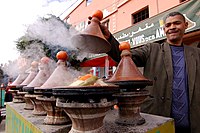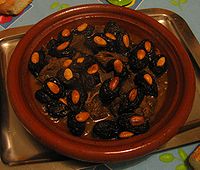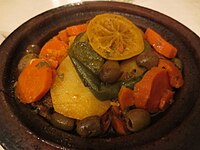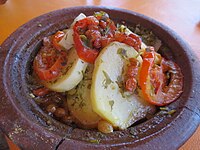Tajine
 A vegetable tajine dish as served in a London restaurant | |
| Type | Stew and Omelette |
|---|---|
| Place of origin | North Africa (Morocco, Algeria, Tunisia) |
| 1,110 kJ (265 kcal)[1] kcal | |
| Other information | Dietary fiber 8 g, sugars 0 g, protein 14 g, total carbohydrate 45 g [1] |
Tajine or tagine (Berber: ⵜⴰⵊⵉⵏ, Tajin) is a North African Berber[2] dish which is named after the earthenware pot in which it is cooked.
Origin
Tagine, an ancient Berber dish, is a succulent stew made of meats and vegetables and traditionally cooked in a conical clay pot to allow the steam to rise, condense, and drip back down to the stew. The traditional method of cooking is to place the tagine over coals, and typically the dish includes meat, chicken or fish, and most often vegetables or fruit. Because this meal takes a long time to prepare, preparation of the lunch tagine begins as soon as breakfast is over.
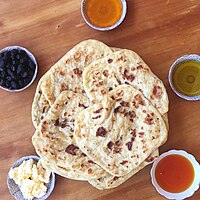 |
| This article is part of a series on |
| Moroccan cuisine |
|---|
|
Main dishes |
| Pastries and desserts |
| Other foods |
| Extinct dishes |
| Beverages |
| Alcoholic beverages |
| See more |
| Related cuisine |
Etymology
There are several theories on the origin of the word tajine:
- from Berber tajin meaning "the special earthenware pot in which it is cooked".
- from Persian tah-chin ته چین meaning "laid at the bottom [of the pan]", referring to the way it is cooked. Tahchin is a Persian food made with rice and meat (chicken or beef). (See Tunisian tajine below and Persian tahchin)
- from Persian tayān تیان meaning skillet or large pan. This word is Arabicized as ṭājin (طاجن) and ṭayjin (طيجن) and ṭajīn (طجين).[3]
- from Ancient Greek: τάγηνον (tagēnon), "frying-pan, saucepan".[4][5][6]
Pottery

The traditional tajine pottery, sometimes painted or glazed, consists of two parts: a circular base unit that is flat with low sides and a large cone- or dome-shaped cover that sits on the base during cooking. The cover is designed to return all condensation to the bottom.
Tajine is traditionally cooked over hot charcoal leaving an adequate space between the coals and the tajine pot to avoid having the temperature rise too quickly. Large bricks of charcoal are used, specifically for their ability to stay hot for hours. Other methods are to use a tajine in a slow oven or on a gas or electric stove top, on the lowest heat necessary to keep the stew simmering gently. A diffuser, a circular utensil placed between the tajine and the flame, is used to evenly distribute the stove's heat. European manufacturers have created tajines with heavy cast-iron bottoms that can be heated on a cooking stove to a high temperature, which permits the browning of meat and vegetables before cooking.
Tajine cooking may be replicated by using a slow cooker or similar item, but the result will be slightly different. Many ceramic tajines are decorative items as well as functional cooking vessels. Some tajines, however, are intended only to be used as decorative serving dishes.
-
Tajine potter
-
Tajine cooking
-
Electrical tajine
-
Tajine used outdoors
Moroccan and Algerian tajines
Moroccan and Algerian tajine dishes are slow-cooked savory stews, typically made with sliced meat, poultry or fish together with vegetables or fruit.[7] Spices, nuts, and dried fruits are also used. Common spices include ginger, cumin, turmeric, cinnamon, and saffron. Paprika and chili are used in vegetable tajines. The sweet and sour combination is common in tajine dishes like lamb with dates and spices. Tajines are generally served with bread. Because the domed or cone-shaped lid of the tajine pot traps steam and returns the condensed liquid to the pot, a minimal amount of water is needed to cook meats and vegetables. This method of cooking is practical in areas where water supplies are limited or where public water is not yet available.
-
Lamb, prunes and almonds
-
Lamb with plum and eggs
-
Tajine with olives and vegetables
-
Tajine
-
Tajine with almonds
-
Tajine with carrots
-
Tajine with lamb and mango
-
Tajine with chicken
-
Tajine with beef
-
Tajine with Vegetable
Tunisian tajine
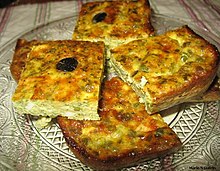
What Tunisians refer to as a "tajine" is very different from the Moroccan dish.[8] Tunisian tajine is more like an Italian frittata or an eggah. First, a simple ragout is prepared, of meat cut into very small pieces, cooked with onions and spices, such as a blend of dried rosebuds and ground cinnamon known as baharat or a robust combination of ground coriander and caraway seeds; this is called tabil.[9] Then something starchy is added to thicken the juices. Common thickeners include cannellini beans, chickpeas, breadcrumbs or cubed potatoes. When the meat is tender, it is combined with the ingredients which have been chosen to be the dominant flavouring. Examples include fresh parsley, dried mint, saffron, sun-dried tomatoes, cooked vegetables and stewed calves' brains. Next, the stew is enriched with cheese and eggs. Finally, this egg and stew is baked in a deep pie dish, either on the stove or in the oven until top and bottom are crisply cooked and the eggs are just set. When the tajine is ready, it is turned out onto a plate and sliced into squares, accompanied by wedges of lemon. Tunisian tajines can also be made with seafood or as a completely vegetarian dish.
In rural parts of Tunisia, home cooks place a shallow earthenware dish over olive-wood coals, fill it, cover it with a flat earthenware pan, and then pile hot coals on top. The resulting tajine is crusty on top and bottom, moist within and is infused with a subtle smoky fragrance.


Other
A similar dish known as tavvas is found in Cypriot cuisine.
See also
References
- ^ a b "Calories in Moroccan Chicken Tagine - Calories and Nutrition Facts - MyFitnessPal.com". myfitnesspal.com.
- ^ Ghillie Basan (2015). Tagines & Couscous: Delicious recipes for Moroccan one-pot cooking. United States: Ryland Peters & Small. ISBN 978-1845979485. page 6.
- ^ "Dehkhoda Dictionary:تیان و طاجن". Dehkhoda Dictionary. Retrieved 20 December 2013.
- ^ Albala, Ken (2011). Food Cultures of the World Encyclopedia, Volume 1. Greenwood. p. 234. ISBN 0313376263.
The Arabic word tajin is derived from the Greek teganon, meaning "frying pan".
- ^ τάγηνον, Henry George Liddell, Robert Scott, A Greek-English Lexicon, on Perseus
- ^ "الطاجين المغربي يقاوم التشويه". BBC Arabic. 31 May 2008. Retrieved 12 December 2012.
- ^ "The Art of Moroccan Cuisine". fescooking.com.
- ^ Paula Wolfert. "Recipe for Tunisian Tajine". Retrieved 2014-07-21.
- ^ Nancy Harmon Jenkins. "Divine Secrets of the Mahjoub Sisterhood". Retrieved 2008-04-27.
Further reading
- Connelly, Michael Alan (December 18, 2014). "20 Must-Try Street Foods Around the World". Fodor's. Retrieved July 24, 2016.
{{cite web}}: Invalid|ref=harv(help)
External links
![]() Media related to Tajines at Wikimedia Commons
Media related to Tajines at Wikimedia Commons


